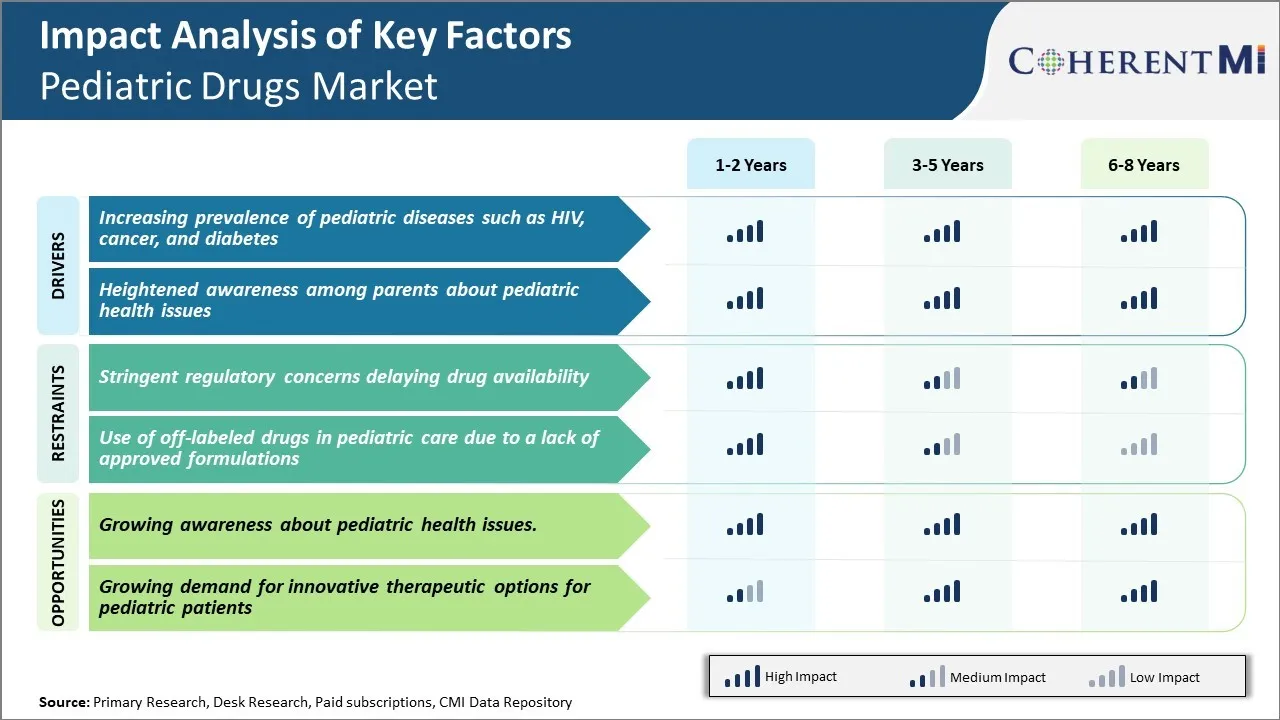Pediatric Drugs Market Trends
Market Driver - Increasing Prevalence of Pediatric Diseases
Various studies have found that conditions like HIV, cancer and diabetes which were previously considered adult-onset diseases are now increasingly being diagnosed in pediatric populations as well. For instance, the United Nations Programme on HIV and AIDS (UNAIDS) estimates that around 160,000 children under the age of 15 got newly infected with HIV in 2021 alone. While access to antiretroviral treatment has moderately improved over the years, pediatric HIV infections continue to pose a major public health challenge especially in developing nations with weak healthcare systems.
Similarly, cancer ranks as one of the top ten causes of death among children aged 5-14 years. As per the American Cancer Society, over 15,000 new cancer cases are reported in children under 15 years every year in the United States. However, continued research into newer drugs aimed at improving cure rates and reducing long term side-effects remains an important driver.
Likewise, the incidence of type 1 and type 2 diabetes is rising at an alarming pace among pediatric populations worldwide. Genetic predisposition coupled with lifestyle changes such as unhealthy diets and lack of physical activity has contributed to the growing prevalence of diabetes in children. This presents lucrative opportunities for drug makers in the pediatric therapeutic segment.
Market Driver - Heightened Awareness among Parents about Pediatric Health Issues
With the proliferation of health information across multiple media platforms, parents today are more conscious about children's wellness. Earlier, childhood illnesses may have sometimes been overlooked as a part of growing up. However, greater health education through online resources and doctor consultations have enabled caregivers to understand potential risks and recognize symptoms early. This has positively impacted the demand for pediatric medications.
Further, social media influencers regularly share updates on latest research and treatment protocols. This keeps parents informed and empowers them to advocate for their child's healthcare needs. It also develops trust in pharmaceutical brands that are transparent with product information. Growing participation in online health support communities allow caregivers to exchange advice and experiences. Such virtual platforms complement conventional one-on-one doctor interactions.
In addition, schools and community programs leverage innovative methods to impart age-appropriate knowledge about personal hygiene, nutrition, exercise and illness prevention. Children learn responsibility regarding medication adherence and healthy habits from a young age.
In conclusion, heightened parental vigilance stemming from improved health awareness is a key secondary driver propelling the pediatric drugs market forward. As child health assumes priority, demand for appropriate medication tailored to pediatric use will correspondingly rise.

Market Challenge - Stringent Regulatory Concerns Delaying Drug Availability
The pediatric drugs market faces significant challenges in obtaining regulatory approval for new medications. Regulators rightly impose strict testing requirements on drugs intended for use in children, as their still-developing bodies can respond quite differently than adults. However, meeting all regulatory guidelines can significantly delay drug availability for pediatric patients. Pharmaceutical companies must conduct lengthy clinical trials specifically in pediatric populations, which are more complex and costly than adult trials due to smaller subject pools.
Additionally, ethical concerns around testing new drugs on children slow the approval process. These stringent regulatory hurdles discourage investments in pediatric drug development, leaving many child illnesses without FDA-approved treatment options. The delays in drug approval pose risks to children's health and make the pediatric drugs market less commercially attractive.
Market Opportunity - Growing Awareness About Pediatric Health Issues
One major opportunity for the pediatric drugs market is the rising focus on children's health issues. Advocacy groups are bringing more attention to diseases that uniquely or disproportionately impact youth. They are also highlighting the lack of pediatric-tailored medications available. As awareness grows, political and funding support for pediatric clinical research is increasing. The 21st Century Cures Act provided over $500 million to study off-patent drugs for children.
Non-profit organizations are also dedicating more resources to pediatric drug development. This boost in funding and political will comes amid a changing social landscape where children's well-being is a higher priority. As awareness continues rising, more treatment options should reach pediatric patients, representing an important growth opportunity for companies in this market.